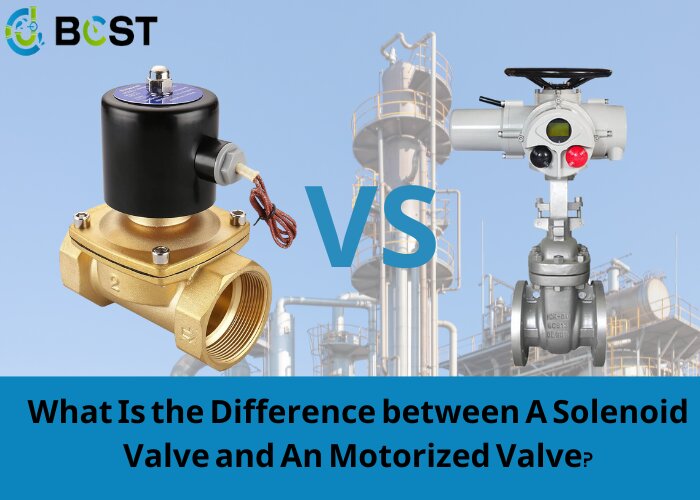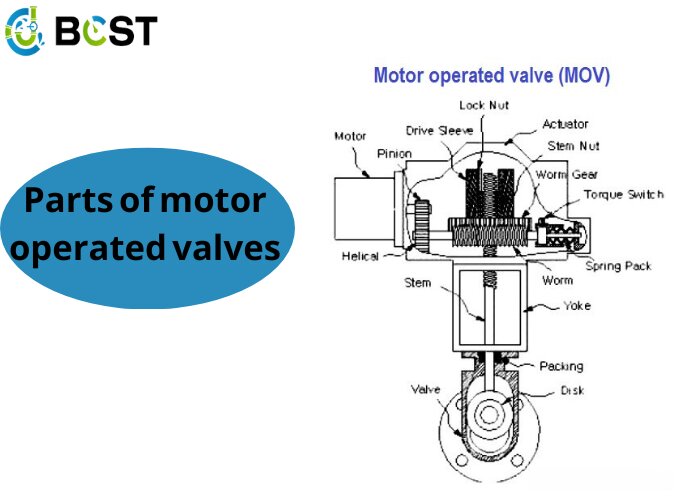
In the world of fluid control systems, valves are unsung heroes. They are essential components that regulate the flow of liquids and gases, ensuring everything functions smoothly. When choosing the correct valve for your specific application, two popular options often come into play: solenoid and motorized valves. Each has its advantages and applications, and making the right choice can significantly impact the efficiency and effectiveness of your system.
A solenoid valve opens and closes the fluid passage to control the fluid passage. When we supply electricity to a solenoid coil, it pulls the magnet toward the eccentric spring. As a result, the piston in its housing rises. Because the solenoid valve contains two springs on each side of the coil, more pressure is required to activate the valve than the ball-type valve.
The plunger is contained within the solenoid cylinder and linked to the solenoid movement mechanism. When the coil of a solenoid valve is energized, an electromagnetic force pushes the plunger to open or close an orifice. When the SV coil is de-energized, the plunger returns to its usual position.
As a result, a solenoid valve generates magnetic force using electricity, and the created force lifts the plunger to regulate the opening or closing of the passage within the valve body. The solenoid valve is typically 14 inches, 3/8 inches, or up to 2 inches in size. We can alter it if we require a larger size, but the fee grows with size.

What is a Motorized Valve?
The motorized valve transforms electric energy into power to drive the rotating ball, which controls the valve’s opening and shutting. An electric motor is used to open or close a motorized valve via a gear train system. The motorized valve is appropriate for fluid flow control applications that need a big valve, such as aviation deicing, agricultural irrigation, and automatic fire suppression.
Motorized valves enable fluid control and regulation based on an electrical signal, which can be either current or voltage. The combination of these valves and control electronics allows them to improve their precision and, as a result, broaden their range of applications.
Its main applications are position and force control because the movements are proportional and precise, allowing more exact management of the liquid passages. They can be categorized into flow and pressure valves.

Difference Between Solenoid Valve and Motorized Valve
- A solenoid valve functions on the electromagnetism principle, in which an electric motor drives a motorized valve.
- Solenoid valves are classified as two-way, three-way, or four-way valves. Motorized valves are classified as quarter-turn, linear, or multi-turn.
- The solenoid valves are intended for usage with water, oil, gas, air fuel, or steam. Depending on the fluid in which they are used, they can also be manufactured of brass, stainless steel, or PVC. Almost any media can be used with a motorized valve.
- The body of the solenoid valve controls the amount of fluid that flows through it, whereas the motor component or actuator of the motorized valve applies the necessary force to get the movement of the body to carry out the regulation.
- Solenoid valves differ from motorized valves in that they feature a motor that drives the mechanism and allows them to be opened or closed.
- Solenoid valves operate in two modes depending on their intended application. The first is direct action, and the second is indirect action. Openings can be two-way, three-way, or four-way. Meanwhile, motorized valves can operate in quarter-turn, linear, or multi-turn modes.
- To open and close the valves, solenoid valves are employed. In contrast, a motorized valve can open and close while also controlling the flow.
- The solenoid’s valve body construction is a plug type, whereas the motorized valve is a ball type.
- When the solenoid valve’s coil receives electricity, it generates a magnetic field and responds quickly to the electric current. This fast process, however, does not enable a smooth movement of fluid. The motorized response, on the other hand, is slow. However, it carefully and accurately controls the fluid. The switching time for a solenoid valve is 0.5 seconds, whereas the switching time for a motorized valve is 1 to 5 seconds.
- The solenoid valve is made up of several small parts, including a coil, springs, plunger, diaphragm, and seals. As a result, they require greater upkeep. Motorized valves, on the other hand, require less maintenance than non-motorized valves.
- The solenoid has a coil that consumes power when the solenoid is in operation. The motorized valve has a higher power consumption during operation. As a result, a solenoid valve consumes less power than a solenoid valve.
- The motorized valve position is maintained even when the power goes out. In the case of the solenoid valve, it is determined by the solenoid valve’s set or reset type function.
- Motorized valves work when a command is issued to their motor. If we remove the command, it will remain in that position because the motor is not receiving power. The following operation can be started by issuing a command from the PLC. As a result, the motorized valve consumes power only when an electric motor is turned on. This increases energy efficiency and reduces heat generation and dissipation. To keep the valve position after a power outage or command withdrawal, a specific solenoid valve must be installed. To maintain a specific position, solenoid valves require a continuous power source to their coil.
- Solenoid valves are ideal for tiny diameters and low flow rates. Because of its rapid action, the solenoid valve’s coil may be destroyed. To eliminate dust and dirt buildup in the plunger and its passage, the solenoid valve should be cleaned on a regular basis. The motorized valves are ideal for controlling huge flows in large-diameter pipes. The valve is slow to function, and the motor can endure voltage transients. As a result, the valve has no special requirements for medium cleanliness.
- The changeover speed of a solenoid is faster than that of a motorized valve.
- Motorized valve body construction is simpler than that of a solenoid valve.
- If there are high-pressure media present, the solenoid valve functions very quickly, which can damage the valve and pipeline. As a result, solenoid valves are vulnerable to damage in the presence of high-pressure fluid. And they are unsuited for such uses. Motorized valves, on the other hand, can operate even at high process pressure.
- Motorized valves need both analog and digital signals to operate, whereas solenoid valves only use digital signals.
- A solenoid valve is appropriate for open-loop control, whereas a motorized valve is appropriate for closed-loop control.
- Solenoids have a lower life span than motorized valves.
- Solenoids have a very small opening. The process medium should be free of dirt and dust. The air quality must be maintained. The motorized valve has no such problem.
Conclusion
Valves, whether controlled by a solenoid or a motor, serve the same fundamental purpose of regulating fluid flow. The choice between solenoid and motorized valves depends on the specific application. Solenoid valves are preferable for fast transition speeds, especially in applications prioritizing speed. They offer rapid linear movement. Additionally, solenoid valves are suitable for small pipelines due to their ease of implementation.
In contrast, motorized valves are chosen when low energy consumption is a priority. They allow precise positioning and can be stopped in specific positions during transitions. Large valves are better suited for motorized control due to their ease of implementation. The decision between solenoid and motorized valves depends on the energy requirements, transition speed, and the size of the system they are intended for.






